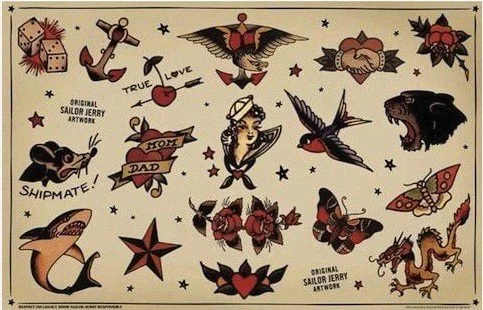Upcoming Events & Tat Blog
Read the Traditional vs. Neo Traditional Tattoos Blog Pt 1 below. We have big upcoming events, first the Asbury Tattoo Beach Bash! All 3 female artists will be tattooing! I hope you made an appointment already! Plus, the My Body My Choice Tattoo Flash Event is happening nationwide on July26, but since we will be at the Asbury Convention, Radiant Energy is having a massive 3 day event! We are the only shop in NJ that is participating, so we want to make sure that everyone who wants a tattoo can get one. Casey is tattooing on 7/30, Koryn on 8/1 and Caroline on 8/2. See our FB event posts for more info or click here.
Traditional vs. Neo Traditional Tattoos: Exploring the Art, History, and Evolution
A Deep Dive into the Enduring Legacy and Fresh Innovations of Two Tattoo Styles
Tattoos have always been more than ink and skin—they are a form of self-expression, an illustration of personal journeys, and, for many, a badge of identity. Among the myriad of tattoo styles that have emerged throughout the decades, two particular genres stand out for their bold aesthetics and deep-rooted history: Traditional and Neo Traditional tattoos. If you’ve ever wondered what separates these two visually striking forms, or if you’re contemplating which style best suits your next piece, this blog will guide you through the art, history, techniques, and cultural significance that distinguish Traditional from Neo Traditional tattoos.
Understanding Traditional Tattoos
Sometimes referred to as “Old School” tattoos, Traditional tattoos are the very embodiment of the Western tattoo legacy. Their roots trace back to the early 20th century, flourishing especially among sailors, soldiers, and adventurers. Artists like Norman “Sailor Jerry” Collins are synonymous with this movement, shaping what we now consider the classic American tattoo style.
Key Characteristics of Traditional Tattoos
• Bold Black Outlines: The defining feature of a traditional tattoo is its clean, thick black outline. This helps the design pop and ensures it stands the test of time as the ink ages.
• Limited Color Palette: Traditional tattoos typically employ a restrained color scheme, favoring primary colors like red, yellow, green, and blue, with little to no shading or gradient.
• Iconic Imagery: Common motifs include anchors, roses, pin-up girls, daggers, swallows, hearts, skulls, and ships. Each image often carries its own symbolism—swallows for safe return, anchors for stability, roses for love, and so on.
• Minimal Detailing: Simplicity is key. The designs are straightforward and focused, allowing for visibility and clarity even as the tattoo ages.
• Durability: The emphasis on bold lines and simple shapes was practical; these tattoos were meant to withstand time and weathering, ideal for those living rough-and-tumble lives at sea or in the military.
The Cultural Legacy of Traditional Tattoos
Traditional tattoos were, in many ways, a form of rebellion and camaraderie. To have ink in the early 1900s was to stand apart from the crowd, to align oneself with a subculture of risk-takers and wanderers. These tattoos were badges—of bravery, of love lost and found, of journeys both literal and metaphorical. Today, they’re celebrated for their vintage charm and historical roots, often chosen by those who want a classic, timeless design.



